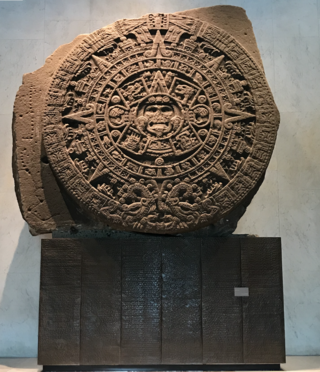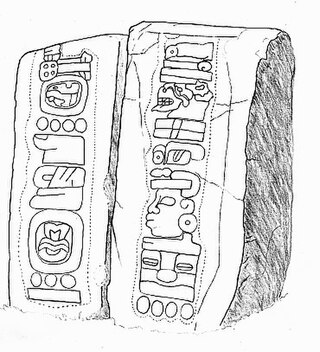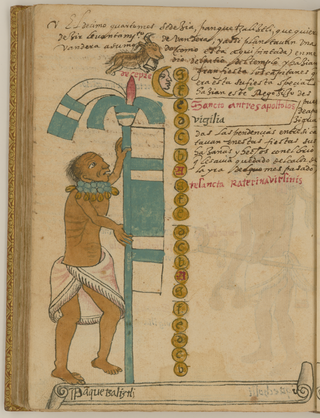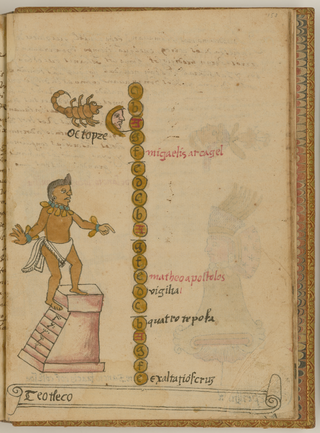Related Research Articles

Tezcatlipoca was a central deity in Aztec religion. He is associated with a variety of concepts, including the night sky, hurricanes, obsidian, and conflict. He was considered one of the four sons of Ometecuhtli and Omecihuatl, the primordial dual deity. His main festival was Toxcatl, which, like most religious festivals of Aztec culture, involved human sacrifice.

In Aztec mythology, Xiuhtecuhtli, was the god of fire, day and heat. In historical sources he is called by many names, which reflect his varied aspects and dwellings in the three parts of the cosmos. He was the lord of volcanoes, the personification of life after death, warmth in cold (fire), light in darkness and food during famine. He was also named Cuezaltzin ("flame") and Ixcozauhqui, and is sometimes considered to be the same as Huehueteotl, although Xiuhtecuhtli is usually shown as a young deity. His wife was Chalchiuhtlicue. Xiuhtecuhtli is sometimes considered to be a manifestation of Ometecuhtli, the Lord of Duality, and according to the Florentine Codex Xiuhtecuhtli was considered to be the father of the Gods, who dwelled in the turquoise enclosure in the center of earth. Xiuhtecuhtli-Huehueteotl was one of the oldest and most revered of the indigenous pantheon. The cult of the God of Fire, of the Year, and of Turquoise perhaps began as far back as the middle Preclassic period. Turquoise was the symbolic equivalent of fire for Aztec priests. A small fire was permanently kept alive at the sacred center of every Aztec home in honor of Xiuhtecuhtli.

The Aztec or Mexica calendar is the calendrical system used by the Aztecs as well as other Pre-Columbian peoples of central Mexico. It is one of the Mesoamerican calendars, sharing the basic structure of calendars from throughout ancient Mesoamerica.
The Hindu calendar, also called Panchanga, is one of various lunisolar calendars that are traditionally used in the Indian subcontinent and Southeast Asia, with further regional variations for social and Hindu religious purposes. They adopt a similar underlying concept for timekeeping based on sidereal year for solar cycle and adjustment of lunar cycles in every three years, but differ in their relative emphasis to moon cycle or the sun cycle and the names of months and when they consider the New Year to start. Of the various regional calendars, the most studied and known Hindu calendars are the Shalivahana Shaka found in the Deccan region of Southern India and the Vikram Samvat (Bikrami) found in Nepal and the North and Central regions of India – both of which emphasize the lunar cycle. Their new year starts in spring. In regions such as Tamil Nadu and Kerala, the solar cycle is emphasized and this is called the Tamil calendar and Malayalam calendar and these have origins in the second half of the 1st millennium CE. A Hindu calendar is sometimes referred to as Panchangam (पञ्चाङ्गम्), which is also known as Panjika in Eastern India.

The Mid-Autumn Festival, also known as the Moon Festival or Mooncake Festival, is a traditional festival celebrated in Chinese culture. Similar holidays are celebrated in Japan, Korea, Vietnam, and other countries in East and Southeast Asia.

The calendrical systems devised and used by the pre-Columbian cultures of Mesoamerica, primarily a 260-day year, were used in religious observances and social rituals, such as divination.

Śrāvaṇa is the fifth month of the Hindu calendar. In India's national civil calendar, Śrāvaṇa is the fifth month of the year, beginning on July 23 and ending on August 22. In the Tamil calendar, it is known as Āvani and is the fifth month of the solar year. In lunar religious calendars, Śrāvaṇa begins on the new moon or the full moon and is the fifth month of the year. Srabon is the fourth month of the solar Bengali calendar. It is also the fourth month of the Nepali calendar. Śrāvaṇa is also the second month of Varsha.

Navaratri is an annual Hindu festival observed in the honour of the goddess Durga also referred to as Adi Parashakti. It spans over nine nights, first in the month of Chaitra, and again in the month of Ashwin (September–October). It is observed for different reasons and celebrated differently in various parts of the Hindu Indian cultural sphere. Theoretically, there are four seasonal Navaratri. However, in practice, it is the post-monsoon autumn festival called Sharada Navaratri.
Tozoztontli is the name of the third month of the Aztec calendar. It means Little Perforation. It is also a festival in the Aztec religion, the deities are Centeotl, Tlaloque, Chicomecoatl and Coatlicue. It marks the end of the dry season. It is the season of bird sacrifices and is called The Little Vigil.
Quecholli is the name of the fourteenth month of the Aztec calendar. It is also a festival in the Aztec religion and the Principal deity is Mixcoatl. It is called the Precious Feather and hunting is done during this season.
Hueymiccaihuitl, also called Xocotlhuetzi, is the name of the tenth month of the Aztec calendar. It is also a festival in the Aztec religion. The Principal deity is Xocotl. It is called Great Feast of the Dead.
Tlaxochimaco is the name of the ninth Month of the Aztec calendar. It is also a festival in the Aztec religion, dedicated to the Aztec God of War Huitzilopochtli. It is called the Bestowal or Birth of Flowers.

Panquetzaliztli is the name of the fifteenth month of the Aztec calendar. It is also a festival in the Aztec religion dedicated to Huitzilopochtli. The correlation of Rafael Tena calculates the twenty-day month as lasting from November 30 to December 19.
Huey Tozoztli also known as Huey Tocoztli is the name of the fourth month of the Aztec calendar. It is also a festival in the Aztec religion dedicated to Tlaloc and other deities. It is called the great or long vigil.

Tecuilhuitontli is the name of the Seventh month of the Aztec calendar. It is also a festival in the Aztec religion. The principal deity is Xochipilli and feasts are also given to Goddess Huixtocihuatl and it is known as the Small Festival of the Lords.

Tepeilhuitl is the name of the thirteenth month of the Aztec calendar. It is also a festival in the Aztec religion dedicated to Popocatepetl, Iztaccihuatl and Tlaloc. It is called the festival or feast of the Mountains.

Teotleco is the name of the twelfth month of the Aztec calendar. It is also a festival in the Aztec religion and is known as the festival of All gods where all gods are worshiped.
Etzalcualiztli is the name of the sixth month of the Aztec calendar. It is also a festival in the Aztec religion dedicated to Tlaloc and Chalchihuitlicue.
Atemoztli is the sixteenth month of the Aztec calendar. It is also a festival in the Aztec religion dedicated to Tlaloc and Tlaloque.

Izcalli is the name of the eighteenth and last month of the Aztec calendar. It is also a festival in the Aztec religion, for which the principal deity is Xiuhtecuhtli the fire God. Old people are honored this month and it is known as Rebirth Month.
References
- ↑ "Hueytecuilthuitli, Great Festival of the Lords, the Eighth Month of the Aztec Solar Calendar". World Digital Library. Retrieved 21 July 2013.
- ↑ Allsopp, Ric; Gough, Richard; Kaye, Nick; MacDonald, Claire, eds. (3 September 1998). Performance Research: On America. Taylor & Francis. pp. 22ff. ISBN 978-0-203-98641-7 . Retrieved 21 July 2013.
- ↑ Manuel Aguilar Moreno (12 September 2007). Handbook to Life in the Aztec World. Oxford University Press. pp. 296ff. ISBN 978-0-19-533083-0 . Retrieved 25 July 2013.
- ↑ "The Aztec Festivals". www.amoxtli.org. Archived from the original on 21 August 2013. Retrieved 25 July 2013.